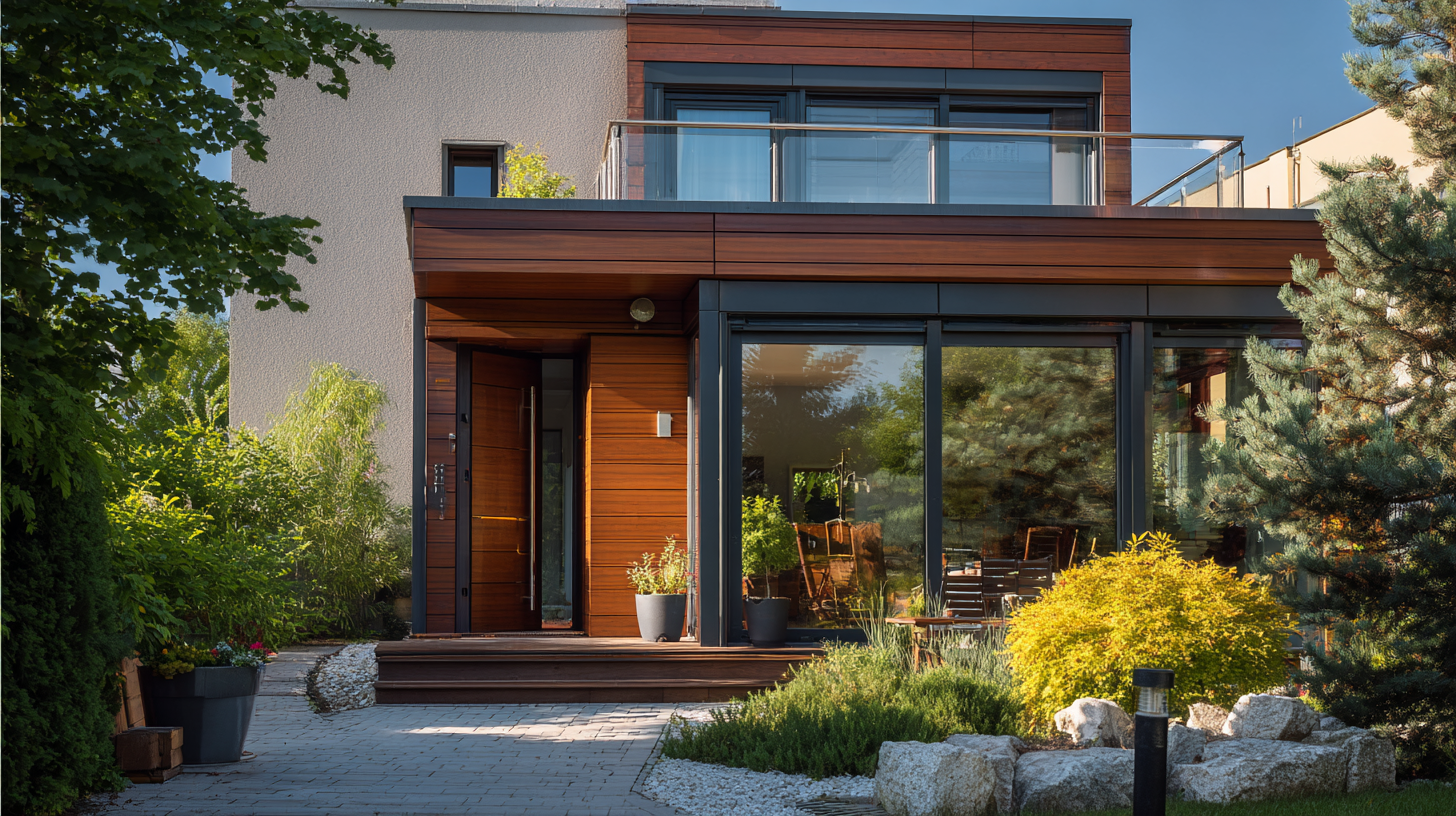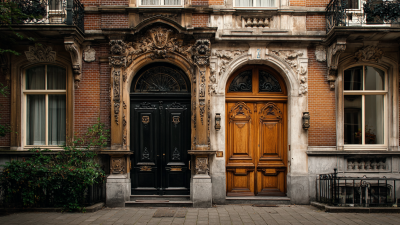Maximizing Energy Efficiency with Smart Doors and Windows for Modern Homes
In today's quest for sustainable living, maximizing energy efficiency in modern homes has become more important than ever, with doors and windows playing a pivotal role. According to the U.S. Department of Energy, nearly 30% of a home's heating and cooling energy is lost through inefficient doors and windows. Advances in smart technology have further enhanced their potential, allowing homeowners to monitor and control their energy usage effectively.
Reports indicate that implementing energy-efficient doors and windows can reduce energy costs by up to 25%, making significant contributions to both environmental sustainability and economic savings. As residential designs evolve, integrating smart doors and windows not only enhances aesthetic appeal but also serves as a crucial step towards achieving optimal energy efficiency in modern homes.

Table of Contents
[Hide]
Incorporating Smart Technology into Your Home's Doors and Windows
In today's rapidly evolving housing market, integrating smart technology into doors and windows has become increasingly important for enhancing energy efficiency. According to a report by the International Energy Agency (IEA), buildings account for nearly 30% of global energy consumption, with windows and doors playing a critical role in thermal performance. By incorporating smart sensors and automated systems, homeowners can significantly reduce energy waste. For example, smart windows equipped with electrochromic glass can automatically adjust their tint based on sunlight exposure, reducing the need for air conditioning and thus lowering cooling costs by up to 30%.

Furthermore, the U.S. Department of Energy states that modern smart doors equipped with biometric access control and connectivity features can enhance security while providing energy reports that help identify inefficiencies in your home's envelope. These systems can also integrate smart home technology, allowing homeowners to monitor energy use in real-time and make informed decisions about when to ventilate or insulate. By leveraging such innovations, homeowners not only improve their comfort but can also potentially increase their property value by up to 5% as energy-efficient technologies become more desirable in the real estate market.
The Benefits of Energy Monitoring Systems for Smart Windows
The integration of energy monitoring systems with smart windows is transforming modern homes into models of efficiency. These systems enable homeowners to track real-time energy usage, providing valuable insights into how windows contribute to overall energy consumption. By collecting data on temperature, sunlight exposure, and indoor climate, energy monitoring tools optimize window operations, such as adjusting tint levels or operability to enhance natural ventilation. This not only ensures comfort but also minimizes reliance on heating and cooling systems, leading to significant energy savings.
Moreover, the advantages of energy monitoring systems extend beyond immediate savings. They create a proactive approach to energy management, allowing homeowners to identify patterns and make informed decisions around usage. For instance, by analyzing data, residents can determine the best times for window adjustments to maximize daylight while reducing glare and heat gain, particularly in warmer months. This smart synergy between technology and design not only helps in lowering utility bills but also contributes to a sustainable lifestyle, making homes more environmentally friendly.
Maximizing Energy Efficiency with Smart Doors and Windows
This chart illustrates the energy savings achieved by using energy monitoring systems with smart windows and doors in modern homes. The data represents the average percentage of energy savings in different categories.
Optimizing Insulation with Intelligent Door and Window Designs
In contemporary home design, optimizing insulation is essential for enhancing energy efficiency, and intelligent door and window designs play a pivotal role.
Advanced materials and technologies allow these openings to provide superior thermal performance. For instance, triple-glazed windows reduce heat loss significantly more than traditional double-glazing, while smart doors equipped with insulation core materials can prevent drafts and maintain a stable indoor climate.
Furthermore, the integration of smart sensors in windows and doors offers real-time environmental monitoring and automated control. These systems can automatically adjust the windows’ tint or open based on temperature changes, effectively regulating heat gain and loss. By utilizing features such as low-emissivity coatings and argon gas fills, modern doors and windows turn into energy-efficient barriers that enhance the overall insulation of the home while simultaneously contributing to a reduction in energy consumption. This intelligent approach not only fosters comfort but also aligns with sustainable living practices, making it a fundamental aspect of modern architecture.
Integrating Smart Sensors for Enhanced Home Security and Efficiency
Smart sensors are increasingly becoming a pivotal component in enhancing home security and energy efficiency, especially within the context of modern homes. These sensors can be integrated into various types of devices, such as security access controls, HVAC systems, and lighting controls. By providing real-time data on a home’s environment, smart sensors facilitate automation that not only enhances security but also optimizes energy use, leading to reduced utility bills. The interconnectivity enabled by these sensors helps homeowners manage their living spaces effectively, adjusting conditions based on occupancy or external weather changes.
The smart home market is poised for significant growth, with forecasts predicting substantial expansion in sectors like smart appliances and HVAC systems. As energy-conscious consumers increasingly seek integrated solutions that prioritize both convenience and sustainability, the integration of smart sensors into everyday devices is becoming essential. Companies are recognizing this demand and investing in innovative technologies that allow for seamless communication between devices, enriching the user experience while promoting a smarter, more efficient home ecosystem.
Maximizing Energy Efficiency with Smart Doors and Windows for Modern Homes
| Feature | Benefit | Energy Savings | Security Enhancement | Cost (USD) |
|---|---|---|---|---|
| Smart Windows | Automatically adjust tint | Up to 30% reduction in cooling costs | Integrated alarm system | $600 |
| Smart Doors | Remote locking system | Reduces HVAC efficiency loss | Real-time security alerts | $800 |
| Smart Sensors | Monitor climate conditions | Contributes to a 20-25% annual energy savings | Access logs and notifications | $150 |
| Smart Home System | Centralized control for devices | Optimizes energy use | Integrated home surveillance | $1200 |
Cost-Effective Solutions for Upgrading to Smart Doors and Windows
Upgrading to smart doors and windows can significantly enhance energy efficiency in modern homes while also being a cost-effective solution. Many homeowners may hesitate to invest in these advanced technologies due to perceived high costs; however, there are various options available that can fit different budgets. For example, integrated sensors and smart glass can regulate temperature and light, reducing reliance on heating and cooling systems, ultimately leading to lower energy bills.

Additionally, government incentives and rebates for energy-efficient upgrades can help offset installation costs. Choosing products that offer long-term savings can make the initial investment more manageable. DIY installations or using a phased approach to upgrading can also further reduce expenses while still reaping the benefits of enhanced security and energy efficiency. By focusing on cost-effective strategies, homeowners can enjoy the modern conveniences of smart technology without straining their finances.
Related Posts
-

Innovative Designs for Doors and Windows That Transform Spaces Globally
-

Exploring Unique Alternatives to Traditional Big Windows for Modern Spaces
-

Top Strategies for Sourcing Stylish Windows in a Competitive Global Market
-

Ultimate Guide to Choosing the Perfect House Windows for Your Home
-

Ultimate Guide to Choosing the Perfect Style Windows for Your Home
-

How to Enhance Your Home Aesthetic with French Windows